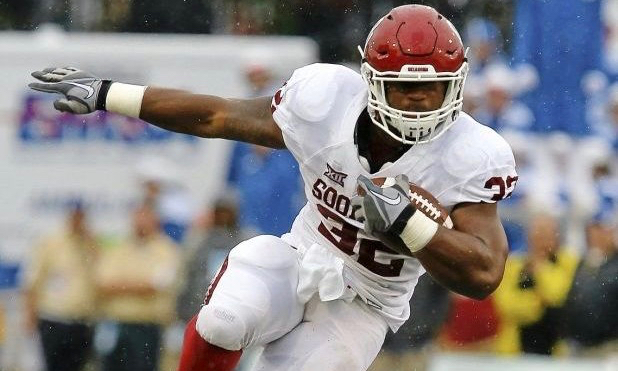Charles Dutton – University of Oklahoma
We’re calling this a “what if” piece. Which, I guess, is some sort of code for getting to let my imagination run wild, which is really just a nicer way of saying I get to rationalize away the past disappointment that a sports team has caused me. It’s therapeutic, really. Likely ultimately detrimental in the long run, but can’t hate on the warm, fuzzy feeling it gives you while you’re doing it. So, without any further adieu, what if the universe shifted the half-dozen prominent L’s on The University of Oklahoma football schedule to W’s on The University of Oklahoma football schedule? No loss to the Saban’s LSU in 2003, no loss to Kansas State in the Big12 championship before that, no loss to the USC juggernaut the next year, no Boise State upset, no loss to Tebow and Urban Meyer in 2008, and just maybe no loss to Clemson in last year’s playoff. I understand that my be leaning pretty heavily on the very concept of “what if”. It’s kind of like saying “what if things were just completely different?”, well it’s hard to say for sure because, you know, everything would be different. I get it. (Author’s note: This was written before the incident in Houston which I have additional takes about, so miss me with that noise.)
But what if? The current narrative on the current state of Oklahoma Football and the Bob Stoops era at large is that OU is a perennial contender and on the top-tier of college football programs, but they don’t exactly have an impressive record in games of special consequence. The Big Game Bob moniker is used with a hint of irony when it is used at all.
Let’s take a step back and look at the macro level. If the Sooners bat .500 in those six games, worst case scenario is they make it to another National Championship and lose again, which admittedly makes things worse when you look at Stoops record changing from 1-3 in National Championships to 1-4, but it’s also not just big games, it’s championships specifically. Now they’re the 90’s Bills, they might be that already.
If, on the other hand, they take even one of those 3 championship games, not even considering if they took multiple, then they go from good-but-can’t-finish to good-won-some-and-lost-some. That’s a major shift. Right now there exists the Bama Tier, the Top Tier, the Second Tier, and on and on. If OU has multiple championships that Bama Tier starts to dissolve in the same way Ohio State and Florida were able to make it dissolve for a time.
Now let’s arbitrarily choose a single one of those games, say OU won it, and think about what that might’ve meant. I choose losing to Saban and LSU in the 2003 National Championship/Sugar Bowl. If you were hoping for something else, sorry. Write your own thing about it. StudentU takes submissions.
OU doesn’t lose that game to LSU 21-14, the Heisman curse can’t hold a candle to Jason White, OU puts up 40 against a good LSU D, and OU has 2 National Titles in 5 years under Bob Stoops. They are the toast of college football. Saban heads back to Baton Rouge and summons a process so focused and so intense it seems to resemble some sort of dark power. He has some sort of dark-curtained voodoo room installed in the team facilities by his office after taking a trip to New Orleans soon after the game. He never leaves LSU, unable to bolt for the NFL after a championship loss, Alabama remains in the middle-to-bottom of the SEC to this day while LSU is the top dog. The Honey Badger wins back-to-back Heisman trophies and Derrick Henry attends Saban-LSU instead of Saban-Bama. We are treated to 2 years of a Fournette-Henry duo in which the LSU offense is a steamroller of sledgehammers and they win back-to-back titles. A strange picture of Saban in a black LSU hoodie – strangly resembling a Belichick look – replaces Joe Carter’s walk-off on Drake’s “Back To Back” and becomes a Sports Illustrated cover.
In the seasons after that game, college football develops no Bama-recruiting-siphon as the juggernaut never develops. The talent spreads across the country, and OU obviously benefits greatly themselves, becoming the unquestioned team of the decade. Being the team of the decade, Oklahoma is pursued seriously by the SEC during conference realignment. It is serious enough that Oklahoma leaves the Big12 with Texas, Texas A&M, Oklahoma State, Missouri, and TCU to join the SEC bringing in the super-conference era. The Big12 is dissolved as leagues consolidate trying to make themselves more competitive, until there are only two major conferences. One made up of the former SEC/ACC and parts of the Big12 with a few additions, and one made up of the former Pac12/Big10 and parts of the Big12 with a few additions (Notre Dame). The two leagues become so big that the National Championship becomes a game played between the two conference champions, and college football surpasses the NFL in size and influence. By 2020 College Football professionalizes – paying players – with universities fielding teams under the tag of Human Physiological Research Programs, attempting to recruit and develop the most freakish athletes possible. As the athletes’ abilities increase the game becomes so violent that players cease moving on to the NFL after college and the league dissolves. Players instead opt to get paid a similar salary for 3-5 years in college and then retire from football.
The world of football is forever changed if OU beats LSU in the 2003 Sugar Bowl.




